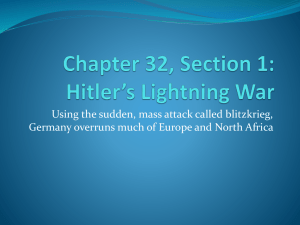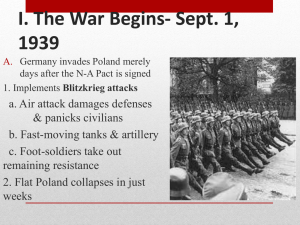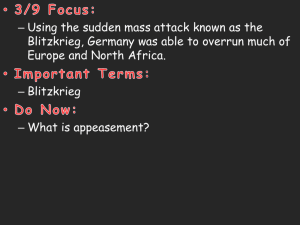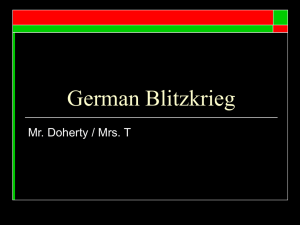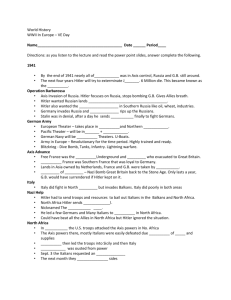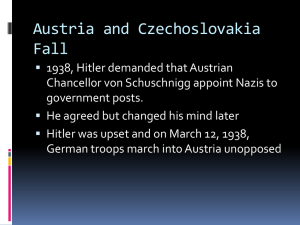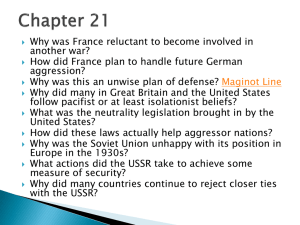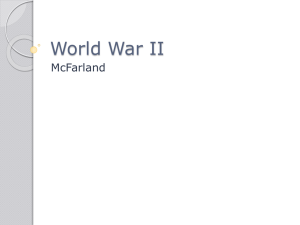World War II European Theatre Study Guide 1) Adolf Hitler
advertisement
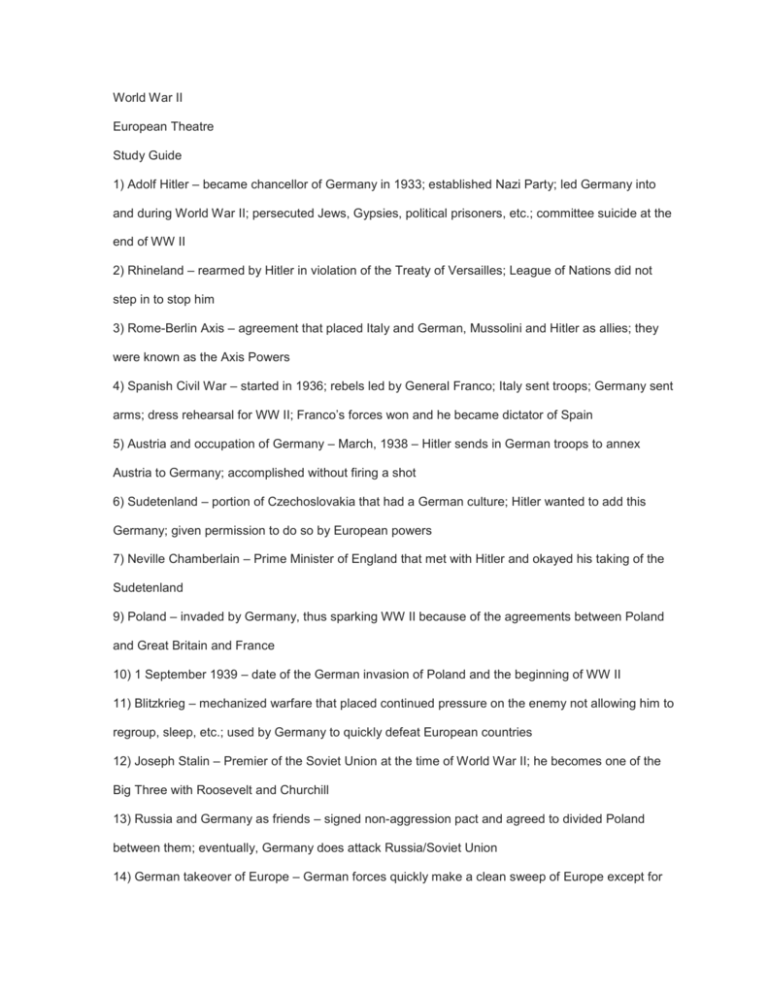
World War II European Theatre Study Guide 1) Adolf Hitler – became chancellor of Germany in 1933; established Nazi Party; led Germany into and during World War II; persecuted Jews, Gypsies, political prisoners, etc.; committee suicide at the end of WW II 2) Rhineland – rearmed by Hitler in violation of the Treaty of Versailles; League of Nations did not step in to stop him 3) Rome-Berlin Axis – agreement that placed Italy and German, Mussolini and Hitler as allies; they were known as the Axis Powers 4) Spanish Civil War – started in 1936; rebels led by General Franco; Italy sent troops; Germany sent arms; dress rehearsal for WW II; Franco’s forces won and he became dictator of Spain 5) Austria and occupation of Germany – March, 1938 – Hitler sends in German troops to annex Austria to Germany; accomplished without firing a shot 6) Sudetenland – portion of Czechoslovakia that had a German culture; Hitler wanted to add this Germany; given permission to do so by European powers 7) Neville Chamberlain – Prime Minister of England that met with Hitler and okayed his taking of the Sudetenland 9) Poland – invaded by Germany, thus sparking WW II because of the agreements between Poland and Great Britain and France 10) 1 September 1939 – date of the German invasion of Poland and the beginning of WW II 11) Blitzkrieg – mechanized warfare that placed continued pressure on the enemy not allowing him to regroup, sleep, etc.; used by Germany to quickly defeat European countries 12) Joseph Stalin – Premier of the Soviet Union at the time of World War II; he becomes one of the Big Three with Roosevelt and Churchill 13) Russia and Germany as friends – signed non-aggression pact and agreed to divided Poland between them; eventually, Germany does attack Russia/Soviet Union 14) German takeover of Europe – German forces quickly make a clean sweep of Europe except for Great Britain 15) Dunkirk – area on the English Channel German forces backed the British/French forces too; troops were rescued from Dunkirk by flotilla from England leaving behind large quantities of military weapons and supplies 16) RAF – Royal Air Force 17) Fall of Paris (rail car) – 14 June 1940 – France surrendered to Germany; Hitler made France sign the surrender in the same rail car used in the surrender of Germany in 1918 18) Charles de Gaulle – formed the French Government in Exile after the fall of France; helped train troops for the invasion of Normandy; returned to France and became President 19) Battle of Britain – Germany bombed Great Britain nightly for months trying to get them to surrender; Britain did not surrender; massive amount of damage and death from the bombing raids 20) Herman Goring – Vice Fuhrer of Nazi Germany and head of the Luftwaffe 21) Sir Winston Churchill – became Prime Minister upon the resignation of Chamberlain; lead Great Britain throughout WW II; one of the Big Three along with Stalin and Roosevelt 23) Invasion of USSR (Barbarossa) – the invasion of the Soviet Union by Nazi Germany; Nazi troops stopped by Russian Winter; the Soviets started fighting back and developed the Eastern Front 24) Isolationist American – US did not want to become entangled with European problems; therefore, stayed out of the beginning of WW II; did not come out from under Isolationism until attacked by the Japanese at Pearl Harbor 25) American Neutrality – US declared itself neutral at the beginning of WW II; however, US did want the Allies to loose 26) “Arsenal of Democracy” – saying by FDR used to show that the US should support those who were fighting for Democracy and against Fascism and Nazism 27) Lend-Lease Act – passed by US Congress; it allowed war materials to be sent to England and other Allies 28) German response to Lend-Lease – U-boats started firing upon American shipping 30) Pearl Harbor – 7 December 1941 – the attack that caused the US to enter WW II because we had been directly attacked by an aggressive country 31) Afrika Corps – German troops operating in North Africa; trying to seize control of Suez Canal and secure a way for Germany to have access to the Middle Eastern oil fields 32) Erwin Rommel – German commander of the Afrika Corps; in charge of defending the French coast against an Allied attack; part of plot to kill Hitler and committed suicide 33) General Sir Bernard Montgomery – British General that battled the Afrika Corps before the US sent troops 35) Italian Campaign – invasion to open another front to relieve some of the pressure against the Soviets; captured Rome, which became the first Axis capital to fall 36) Dwight D. Eisenhower – Overall Allie Commander for the D-Day operations 37) D-Day – 6 June 1944 38) Operation Over Lord – code name for the Allied invasion of the French coast 39) Normandy – area of France attacked by Allies to establish a beach head and start the process of pushing the Germans back 40) Utah and Omaha Beaches – code name of the beaches attacked by the Americans on D-Day 41) Gold, Sword, & Juno Beaches – code name of the beaches attacked by the British, etc. 42) George S. Patton – US commander of the American Third Army in Europe; helped to push the “Bulge” out of the Allie lines by turning the Army 43) Omar Bradley – US commander that pushed the Germans back into Germany 44) Battle of the Bulge – last German offensive in December and January 1944/1945; initially a success but eventually lost their momentum and the Allies pushed the German forces back 45) Fate of Adolf Hitler – committed suicide to prevent himself from surviving the Third Reich 46) V-E Day – Victory in Europe Day celebrated in the United States 47) 7 May 1945 – date of Germany’s surrender to the Allied forces Europe 1939-1945 1. How did the following led to WWII? Aggression of Totalitarian Powers-Dictators built up their armies Nationalism-Countries formed alliances and demanded obedience Treaty of Versailles-Extremely harsh to the Axis Powers League of Nations-Couldn’t enforce its rules Appeasements-France and England gave in to German Aggression 2. What was life like for civilians under Hitler, Mussolini and Stalin?No individual freedoms 3. What is Anti-Semitism?Hatred of the Jews 4. What was the non-aggression pact? Germany and the Soviet Union agreed not to attack each other and divide up Poland 5. event sparked the war?Invasion of Poland 6. How was Hitler able to defeat France? Which country entered the war to “help” defeat France? Hitler used Blitzkrieg and used the help of Italy 7. Who made up the Axis powers?Japan, Italy, Germany 8. Who made up the Allies? Soviet Union, Britain, United States 9. What area did Hitler and Mussolini focus on after Britain?Soviet Union 10. What operation did Hitler implement to conquer Russia? Barbarossa 11. What did Stalingrad stop the Germans from doing? Conquering the Soviet Union 12. When did Pearl Harbor occur?Dec 7, 1941 13. Who was the British Prime Minister during WWII?Winston Churchill 14. How were the Axis powers defeated in Africa? (What battle)El Alamein 15. When did Italy surrender?1944 16. Where and when did D-Day take place?June 6, 1944 Normandy France

